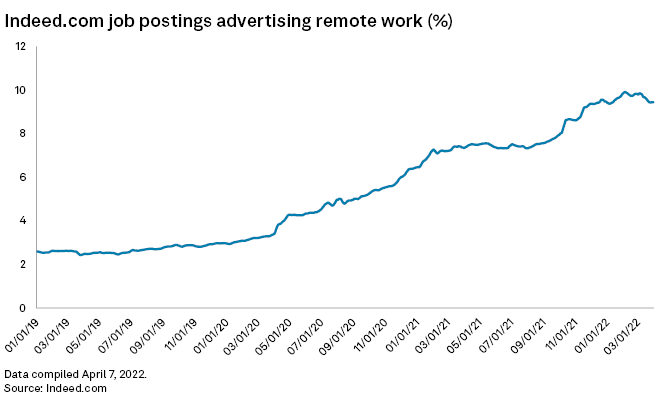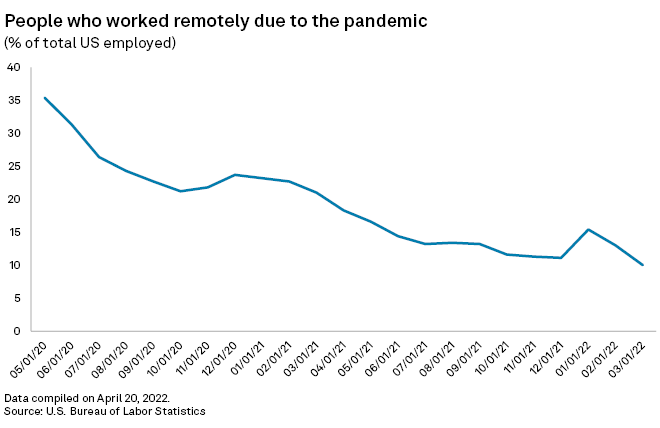S&P Global Offerings
Featured Topics
Featured Products
Events
S&P Global Offerings
Featured Topics
Featured Products
Events
S&P Global Offerings
Featured Topics
Featured Products
Events
Banking & Capital Markets
Economy & Finance
Energy Transition & Sustainability
Technology & Innovation
Podcasts & Newsletters
Banking & Capital Markets
Economy & Finance
Energy Transition & Sustainability
Technology & Innovation
Podcasts & Newsletters
S&P Global Offerings
Featured Topics
Featured Products
Events
25 Apr, 2022

By Brian Scheid

The number of U.S. employees working remotely has fallen to the lowest mark since the start of the pandemic, but more workers are seeking flexible work arrangements as employers struggle to fill open positions.
The work-from-home movement in the U.S. is at an inflection point.
Two years after COVID-19 drove millions of Americans out of their cubicles, workers are seeking out a growing number of remote job listings and are fighting to keep work-from-home policies in place at their current jobs. Some employers, meanwhile, are quickly moving away from decades-old ideas of where and how an employee works as they face one of the tightest domestic job markets in history.
"More and more workers are demanding the opportunity to at least spend some time working remotely," said Moe Vela, a board member with TransparentBusiness, a software-as-a-service provider which specializes in remote work. "This is what employees want and employees are in the driver's seat right now."
Remote listings rise, workers fall
At the end of March, roughly 9.4% of job postings on indeed.com, an employment site, advertised remote work, up from 3.4% at the end of March 2020 and near its highest level since the pandemic began.

During the same month, 10% of all employed Americans worked remotely at one point during the month due to the pandemic, down from 13% in February, according to the Bureau of Labor Statistics' latest data. March was the lowest point since the BLS began tracking the number in May 2020.
The number of workers who remain working fully remote shortly after the pandemic's effects end will likely stabilize around 10% to 12%, according to Charles Gascon, a senior economist at the Federal Reserve Bank of St. Louis. The number of workers in a hybrid model could be about 25%, Gascon said.

More prospective workers were seeking more remote work opportunities and businesses were racing to adapt, according to the Federal Reserve's April 20 beige book, a summary of economic conditions from its 12 districts.
Some job seekers turned down offers from companies because positions were not hybrid or fully remote, officials with the Federal Reserve Bank of Richmond said. Many employers had begun offering more flexible working arrangements.
Several companies that resisted hybrid and remote scheduling started offering workplace flexibility to retain workers, officials with the Federal Reserve Bank of Atlanta said.
A new office
To attract and retain talent, employers are offering more remote and hybrid work options, reducing the overall size of their offices while also expanding space for employees to collaborate and socialize.
"These are new models of work," said Conner Forrest, a senior research analyst at 451 Research. "The traditional model of how we think about work, in an office from 9 to 5, is dead or dying."

A 451 survey of 500 companies released late last year found that 34.2% planned to adopt a hybrid workplace model at some point this year, where employees might work three days in the office, two days remote or some other similar schedule. The survey found that many planned to reduce their company's office footprint, with 23.6% reducing the number of individual offices or cubicles on-site.
At the same time, however, the survey found that 27% of companies were planning to add more features to their offices, such as building more meeting rooms or huddle rooms for employee collaboration. Some 25% of companies planned to add "downtime spaces" such as coffee bars and cafeterias to boost socialization among employees.
Companies, Forrest said, appear to be investing equally in reducing the size of their workplaces while also adding space for collaboration.
"We're not necessarily being pulled in different directions, we're just heading full-steam ahead in both directions," Forrest said.
'What's the point?'
Andrew Berman, co-founder and CEO at Vowel, a virtual meeting platform, had worked remotely for the entire pandemic. With his team spread throughout the U.S. and Canada, he organized an on-site work week in San Francisco in late March with his management team.
While it was nice to chat with his colleagues in person, the majority of everyone's day was spent trying to find an open room to get on a video chat with another employee or client who was not in the office.
After a week, Berman said he was convinced that offices with open floor plans and a workforce that shows up and leaves at roughly the same times on the same days had become an outdated idea.
"Even if you force everyone back into the office on the same day, it just doesn't work," Berman said. "Somebody's kid is at home sick, somebody has COVID themselves, somebody lives two hours away and just can't take the train today. So you end up sitting in a room crouched around a laptop. So what's the point?"
'Serious weaknesses'
Some employers, including The Goldman Sachs Group Inc., have pushed back against this criticism, saying that in-office work is necessary for collaborative efforts, experience and professional relationships.
In an April 4 letter to shareholders, Jamie Dimon, chairman and CEO of JPMorgan Chase & Co., wrote that remote work has "serious weaknesses," including a heavy reliance on Zoom meetings that slow down decision marking, an elimination of spontaneous learning and creativity found working in person, and a hindrance to apprenticeships made more difficult over Zoom.
"Performing jobs remotely is more successful when people know one another and already have a large body of existing work to do," Dimon wrote. "It does not work as well when people don't know each other."
Privileged few
Remote work opportunities are, at the moment, concentrated among a select group of workers, primarily highly educated workers working in white-collar industries.
About 22% of workers with advanced degrees worked remotely in March, compared to 3.2% of workers with only a high school degree and 1.4% of workers without a high school diploma, according to the latest government data. Among professions, 28.3% of workers in business and financial operations occupations and 37.4% of workers in computer and mathematical occupations worked remotely, while just 1.7% of employees in service occupations worked remotely.
According to a survey this month by ETR, a technology market research firm, 42% of tech companies are fully remote, while 31% are hybrid. This compares to 60% of companies that were fully remote and 33% hybrid as of ETR's June 2021 survey.
Tech companies now expect about 25% of their workforce to be permanently remote, compared to 31% in June 2021, according to ETR.
"It's still an overwhelming number," said Erik Bradley, chief strategist with ETR. "Two years ago, we thought this was temporary."
451 Research is part of S&P Global Market Intelligence.
